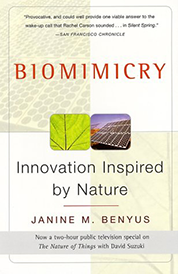Dr. Janine Benyus, biologist and innovation consultant, is the creator of Biomimicry, an emerging discipline that seeks sustainable solutions by emulating nature's designs and processes.
Janine is the author of six books including "Biomimicry: Innovation Inspired by Nature". Since the book's 1997 release, Janine has evolved the practice of biomimicry, consulting with sustainable businesses and conducting seminars about what we can learn from the genius that surrounds us. Her favorite role is that of biologist-at-the-design-table, introducing innovators to organisms whose well-adapted designs have been tested over 3.8 billion years.
In 1998 Janine co-founded the Biomimicry Guild with Dr. Dayna Baumeister. The Guild is an innovation consultancy providing biological consulting and research, workshops and field excursions. The Guild helps designers learn from and emulate natural models with the goal of developing products, processes, and policies that create conditions conducive to life.
Janine now helps organizations invent eco-friendly products and processes. For Nike, it resulted in the creation of a swimsuit based on shark's skin. To help a 1 billion carpet-tile manufacturer reduce waste, Benyus's team turned to the forest floor for inspiration and designed a line of tiles inspired by the randomness of fallen leaves. They also studied geckos and beetles to find a better form of adhesives.
Her clients have included HOK, Arup Engineers, Boeing, Carollo Engineers, Colgate-Palmolive, Cook + Fox Architects, General Electric, Gensler Architects, General Mills, Herman Miller, Hewlett-Packard, IDEO, Kohler, Kraft, Levi's, NASA, Nike, Norm Thompson, Novell, Patagonia, Procter and Gamble, SC Johnson, and Seventh Generation.
As a result of working with the Biomimicry Guild, the world's largest commercial carpet manufacturer introduced Entropy/I2, a carpet inspired by random pattern formation in nature. In record time, it rose to become InterfaceGlobal's top-selling line of carpet, representing 40% of their carpet tile sales.
Janine has introduced tens of thousands of people to biomimicry through international keynotes including Amana-Key Executive Leadership Training in Brazil, American Institute of Architects, American Institute of Chemical Engineers, Aspen Ideas Festival, Cambridge University's Centre of International Studies and the Environment, Canadian National Roundtable for the Economy and the Environment, Design Futures Council, Fortune Brainstorm Green, and many others.
In 2005 Janine founded The Biomimicry Institute (TBI), a nonprofit organization dedicated to nurture and grow a global community of people who are learning from, emulating, and conserving life's genius to create a healthier, more sustainable planet. TBI offers biomimicry workshops for designers (engineers, architects, etc.) as well as biologists through the biologist-at-the-design-table training.
Janine has received several awards including a Time Magazine's Heroes of the Environment award, the Rachel Carson Environmental Ethics Award, the Lud Browman Award for Science Writing in Society, and the Barrows and Heinz Distinguished Lectureships. In 2009, Janine was honored with a Champion of the Earth award in Science & Innovation from the United Nations Environment Programme.
An educator at heart, Janine believes that the more people learn from nature's mentors, the more they'll want to protect them. This is why she writes and revels in describing the wild teachers in our midst.




